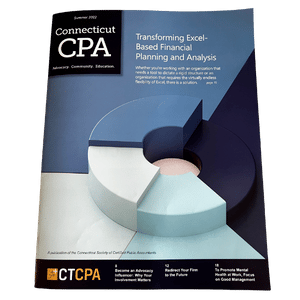July 11, 2022

Jim Norton’s featured article on financial planning and analysis in CTCPA Magazine
By CTCPA Advisory Council Chair Jim Norton
This article was printed in the Summer 2022 issue of Connecticut CPA Magazine
Go to most midsize or above business software pages right now and keep track of how many times they talk about “outgrowing Excel” and the urgent need to replace Excel. In reality, try as we might to replace Excel, there will never be a day where it is 100% removed from most businesses.
In most cases when software tools are trying to replace Excel, they are totally and objectively right. Excel is not a database, an accounting system, a timesheet and expense report tool, or a workflow engine.
Where many organizations blur the line (and will probably always continue to blur the line) is financial planning and analysis (FP&A) and budgeting and planning. Without question, we see most clients starting out with – and a surprising amount never leaving – Excel for this function.
Here’s the thing: It’s possible to have an enterprise-quality FP&A function with native Excel as your user interface. You need the right solution to make it happen.
In my article “Financial Planning and Analysis Tools: Your Organization’s Crystal Ball” in the Spring 2022 issue of Connecticut CPA magazine, I wrote about FP&A tools that can replace Excel. In that article, I told you all about indicators that an organization has outgrown Excel for planning. I also told you about the must-have traits for a strong FP&A tool.
At this point you’re thinking, “OK, Jim … You’re sending me mixed signals now. Last quarter you told me about outgrowing Excel and finding the right FP&A tool. Now you’re telling me organizations can have enterprise-quality FP&A with Excel as the user interface. Which is it?” The answer is both.
Trying to adapt solutions that force certain workflows and behaviors can work in the right organization. Some teams crave rigid structure; some teams may not be in a position to come up with their own structure and workflows; some teams are not proficient Excel users … There are a variety of reasons that they gravitate to the “pre-built” FP&A tools that yell from the rooftops about getting out of Excel.
In those cases, great. Explore solutions like those I mentioned last quarter. You’ll surely be very happy.
When it comes to FP&A solutions, what a lot of the market doesn’t like to talk about as much is the elephant in the room: It takes
the right kind of organization to adopt a traditional FP&A tool successfully. Otherwise, users revert to Excel anyway!
Finance leadership is not always in sync with the rest of the organization. In 2021, BPM Partners – an advisory firm that focuses on business performance management solutions – conducted a survey of finance professionals that found that more than 80% continued to leverage Excel for planning even after purchasing FP&A software intended to replace Excel.
In the Forbes article “The Death of Excel Has Been Greatly Exaggerated,” author Hunter Madeley states that “Put another way, there appears to be a disconnect between some finance leaders, who are instructing their staff to stop using Excel to get work done, and their team members, who are highly reluctant to give it up, as witnessed by the survey findings.”
If you or your clients might NOT be the kind of organization that can adapt a traditional FP&A tool successfully, you can do one of two things when faced with this reality: Fight it or embrace it.
Assuming you want to be progressive enough to not dig your heels in and fight a losing, uphill battle, let’s talk about how to embrace it. No one is disputing the risks of Excel. People make errors. They break formulas. There are hundreds of different worksheets and versions that exist separately for security and all other variety of reasons, which someone has to spend massive time consolidating to get a full organizational picture. But what if I told you that the reason you face these challenges is because you’re trying to use Excel as a database instead of simply leveraging it as an interface?
Put aside for a minute the integrations, complex formulas, consolidation needs, multi-currency, security, and all the other complexities that give you headaches in Excel-based planning. Let’s assume that those can all be solved. (Spoiler alert: They can, and they have been.)
As Madeley states, “Excel remains the leading spreadsheet program in the world for all sorts of reasons:
- It’s flexible.
- It has strong modeling capabilities.
- It can accommodate powerful calculations.
- It offers rich presentation options.
- It boasts a high user adoption.”
In the evolving world of FP&A solutions, tools exist that are meant to transform your Excel-based planning from a debilitating risk into a resounding value-add. These solutions take all the things that are great about Excel and put controls around the things that are problematic.
No more worrying about needing 20 different versions of a workbook to control data visibility on a need-to-know basis. No more worrying that someone adding a row or column is going to break a formula. No more manual data imports and exports to get your baselines.
Users can pull their insights and provide their inputs in Excel, but behind Excel is a robust cloud-based database that is instantly and continuously consolidating your data so that the full picture of your organization is ready with a moment’s notice. Behind Excel you have hundreds of integrations to that database feeding in data from your accounting and operational systems for full-context planning. Behind Excel is a fully configurable workflow engine for you to build processes ranging from a reporting cadence to a full review and approval cycle to be as simple or granular as you prefer.
If you explore solutions that give you Excel-based budgeting and planning, do so carefully. Many solutions on the market will say they have an Excel-like interface. They will offer proprietary spreadsheet tools that behave “similar to” Excel. That’s not what we are talking about here.
We are talking about quite literally using Excel as the user interface, if you want to capitalize on the fact that there’s virtually no learning curve since people already know Excel.
As Madeley states, “When you go looking for such a platform, ask the following questions:
- Are all datasets available for analysis, budgeting, planning and reporting in Excel?
- Does the platform support complex and seamless model building, templates and all Excel formulas?
- Does it enable you to share your work with ease, including distributing reports, sharing budgets, and providing a seamless, businesswide experience?
- Is there one unified interface allowing you to import and leverage existing Excel templates and processes quickly?”
If you’re looking for names of solutions to check out in this arena, two prominent tools in the market are Vena and DataRails. Like the broader FP&A tool marketplace, new players come up frequently and the market for this type of FP&A tool will inevitably achieve saturation in the future.
So, to conclude the discussion on FP&A tools that has spanned the first two quarters of 2022, let’s close on this note: Whether you’re working with an organization that needs a tool to dictate a rigid structure or an organization that requires the virtually endless flexibility of Excel but needs to put controls and efficiency around it, there is a solution on the market.
The only mistake you can make at this point in the current business environment is failing to prioritize the FP&A function. Invest in the FP&A function and your future organization will be stronger for having done so.

He helps clients leverage software in developing the creative, functional solutions they need to address their business’ process and reporting challenges. He can be reached at www.linkedin.com/in/jamesanorton.
Madeley, H. (2022). The Death of Excel Has Been Greatly Exaggerated, Forbes Technology Council. www.forbes.com/sites/forbestechcouncil/2022/04/11/the-death-of-excel-has-been-greatly-exaggerated.
